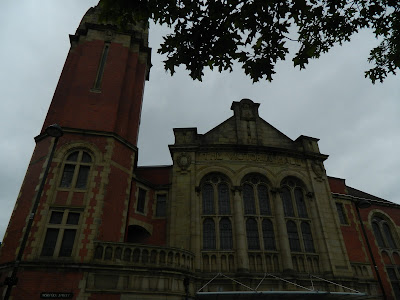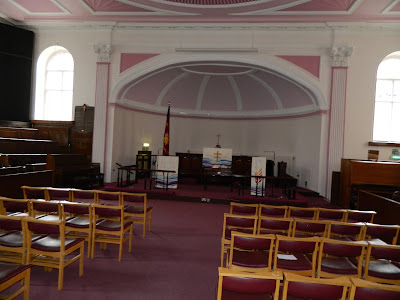 |
| Memorial Plaque |
Our last full day on our travels, as we need to return home tomorrow, as the day is overcast we set out for Sheffield, during the 18th century many people left their rural villages and went to the city to
seek employment. John Wesley visited the town on 42 occasions, the first in June 1742, Charles came the following year. John's last visit was in July 1788, at the age of 85. It was on 15th July 1779 that John preached in the Georgian Paradise Square from the balcony of No 18, reached at the time by a flight of stone steps, making it an ideal place to preach after being "banned from the Parish Church". John records in his journal for that day that he 'preached to the largest congregation he ever saw on a weekday' today a wall plaque marks the spot.
 |
| Paradise Square |
 A few yards from the square stands Sheffield Cathedral, which is Sheffield's oldest building, formerly Sheffield's Parish Church. It has its origins in the 12th century. Over the centuries the building has changed, notably in the 1960's and more recently in 2014. Wesley preached here in July 1780 are records, "there were afterwards 'such a number of communicants' as was never seen at the old church before." We were keen to see the stained glass window recalling Wesley preaching in Paradise Square, which was to be found in the Chapter House which was not open to the general public.
A few yards from the square stands Sheffield Cathedral, which is Sheffield's oldest building, formerly Sheffield's Parish Church. It has its origins in the 12th century. Over the centuries the building has changed, notably in the 1960's and more recently in 2014. Wesley preached here in July 1780 are records, "there were afterwards 'such a number of communicants' as was never seen at the old church before." We were keen to see the stained glass window recalling Wesley preaching in Paradise Square, which was to be found in the Chapter House which was not open to the general public.
However with the permission of the Verger we managed to sneak in and see it. In the same room the Cathedral also keeps a desk used by John Wesley to write his sermons whilst in Sheffield, however it seemed that someone had moved it to another place, as I commented to our guide, maybe the Dean was using it as inspiration for his sermons, - "could be" came the reply, "as they are always very good!"
 |
| Can you find John Wesley? |
The Cathedral has another stained glass window showing John Wesley (bottom right panel) in the Chapel of the Holy Spirit which was part of an extension to the Cathedral complex in 1930's dedicated to the Te Deum. - We were grateful to the Cathedral guides for showing us these things.
Is this liturgical Table Tennis? - saw this outside the Cathedral
Just a short walk from the Cathedral, though Chapel Walk is Victoria Hall Methodist Church found on Norfolk Street. We had coffee in the entrance area where they serving refreshments. The "Central Hall" style church is built on the site of a previous Norfolk Street Chapel, where John Wesley was the preacher at the official dedication/opening service in 1780.
It was a busy building, but we only received a luke-warm welcome. The building cost £40,000 and could seat 2,350 in the main worship area. Upstairs there are 18 rooms which were originally all class rooms. In 1966 the building was refurbished at the cost of £80,000 twice the original when the Worship Area was reduced to 950 capacity by inserting a floor to create a lower hall. The glass ceiling is impressive!
 |
| The main Worship Area |















































